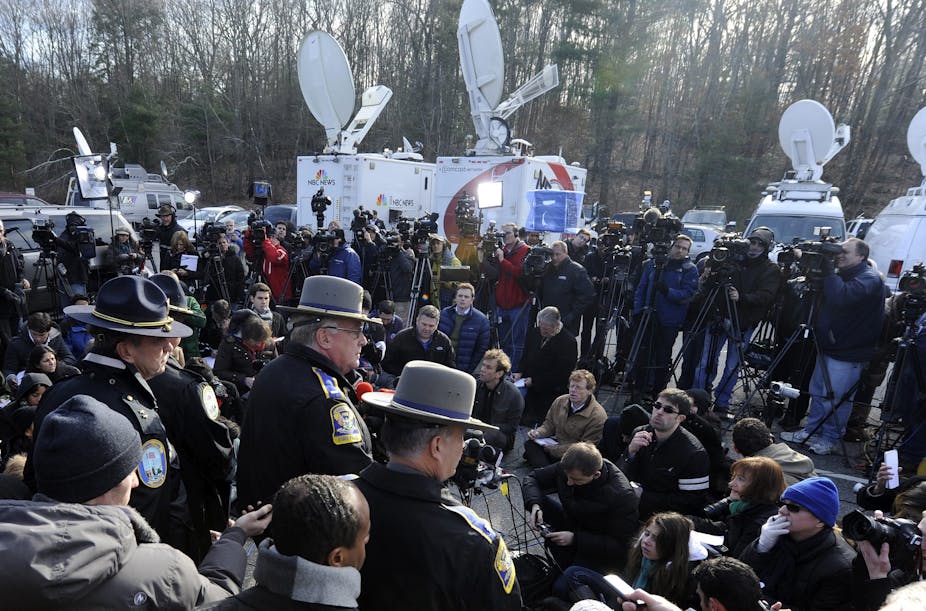As Newtown tries to come to terms with the execrable, it isn’t clear if television news has been a help or a hindrance. According to the New York Times, CNN’s Wolf Blitzer has acknowledged the challenges of reporting the story with decorum. NBC’s Pete Williams has confessed that fact checking procedures have sometimes faltered.
Concerns have particularly centred on the ethics of interviewing traumatised children. Others within the community have spoken, however, about the benefits of a media presence.
In all of this, it is clear that good journalism is vital. And we can learn a lot from how the mainstream media covered past massacres.
After 1999’s Columbine murders, film critic Roger Ebert attacked television news. NBC asked Ebert to explain how the murderers may have been provoked by movies. Ebert countered that he’d rather blame journalists. If any part of the media encouraged grand scale slaughter, he argued, it was surely news outlets who guaranteed round-the-clock attention and infamy.
Research on news coverage of school mass murders supports some of Ebert’s accusations. Media scholars have suggested the tendency to blame music, movies and video games was fairly typical of post-Columbine journalism.
Researcher Glenn Muschert’s extensive analysis of this coverage has noted how much of it relied upon the image of the “juvenile super predator”. Eric Harris and Dylan Klebold were depicted as icons of an immoral generation who were driving an inexorable increase in violent crime. The super predator myth made for easily digested news. But it discouraged analysis of the social conditions that make school violence a familiar feature of American culture. According to studies of the Finnish experience with these atrocities, the advent of social media has made sober analysis harder still, as journalists fight for public attention amidst the clamour of digital rumour.
Where Ebert was probably wrong was in arguing the main effect of this coverage was to encourage copycat behaviour. While there are copycat elements to these crimes – the shooter in 2007’s Jokela murders participated in online communities dedicated to Harris and Klebold – that is not the whole story.
The effects of media violence are never direct. Psychologist Albert Bandura argues that young people learn from media violence, but also cautions that they only act on this violence when it is presented to them in particular ways, when they have a social motivation for wanting to replicate it, and when they have the opportunity to do so in a way that promises rewards. And the most significant effects of media violence might be the ones that we can’t see so obviously.
Since the 1970s, media scholars have quantified the amount of violence on television, compared the rate of this violence against the real thing, and looked at the differences in political attitudes between light and heavy viewers.
Among the various findings from these studies, three standout as pertinent to Newtown.
First, television frequently exaggerates the scale of real world violence. Second, people who see a lot of violence in the media are often significantly more likely to believe that they will fall victim to it. Third, some studies have found that people who consume a lot of images of crime and violence are more distrustful of other people, more supportive of gun ownership, and more likely to own a gun.
This research raises a chilling possibility. Repetitive stories about heavily armed men carrying out mass murder in educational institutions seem a clear call for tighter gun laws. But studies of audiences suggest many viewers see things differently. Media violence scares people, especially when it resonates with the things they experience in their own communities. More importantly, this fear changes how they relate to their surroundings. These findings are consistent with the fact that, as Sky News reported yesterday, gun sales in Newtown have risen since the weekend.
So there are reasons for thinking that simplistic, sensationalistic news coverage can make things worse, as societies endeavour to make sense of school shootings. However, the news media are aware of these problems, and try to embrace them in their practices.
After the Virginia Tech shooting in 2007, NBC host Bryan Jennings discussed the ethical dilemma of what to do with Cho Seung Hui’s “manifesto”. This did not insulate the network from criticism, but it was a step forward for media coverage of this kind of event. On Sunday, ABC news in the US ran a segment on how to discuss Sandy Hook with kids who might be too afraid to return to school, because of what they’ve seen on TV.
Newtown needs good journalism. It’s a vital to the police, as they endeavour to silence social media chat and malevolence that threatens the investigation. Poignantly, it’s also a resource for a community that wants to ensure the world remembers the victims.
Since Columbine, we’ve learned a lot about what can go wrong with the reporting of school shootings. Enough journalists are sensitive to these lessons to make a difference, or at least to create a useful public debate about the journalism we want to have.

